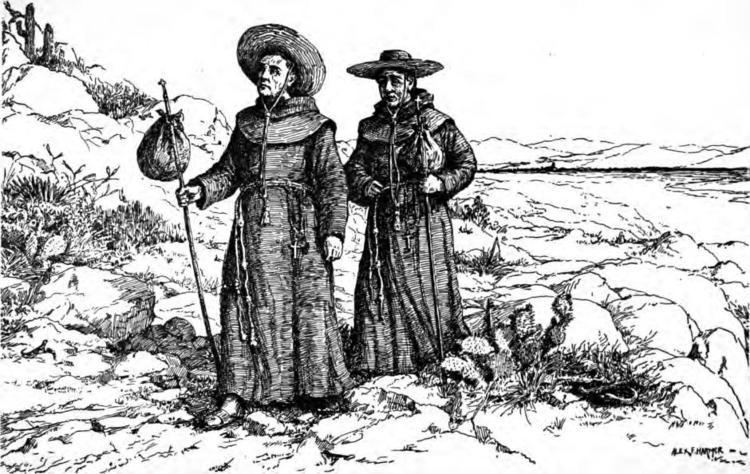The Spanish missions in the Sonoran Desert are a series of Jesuit Catholic religious outposts established by the Spanish Catholic Jesuits and other orders for religious conversions of the Pima and Tohono O'odham indigenous peoples residing in the Sonoran Desert. An added goal was giving Spain a colonial presence in their frontier territory of the Sonora y Sinaloa Province in the Viceroyalty of New Spain, and relocating by Indian Reductions (Reducciones de Indios) settlements and encomiendas for agricultural, ranching, and mining labor.
Geography and history
The missions are in an area of the Sonoran Desert, then called "Pimería Alta de Sonora y Sinaloa" (Upper Pima of Sonora and Sinaloa), now divided between the Mexican state of Sonora and the U.S. state of Arizona. Jesuits in missions in Northwestern Mexico wrote reports that throw light on the indigenous peoples they evangelized. A 1601 report, Relación de la Provincia de Nuestra Señora de Sinaloa was published in 1945. An important Jesuit report concerned the resistance in 1691 of the Tarahumara to evangelization, Historia de la tercera rebelión tarahumara. Another important Jesuit account of evangelization in Sonora is Estado y descripción de Sonora, 1730, which has considerable information about the size of the indigenous population, culture, and languages.
In the Spring of 1687, Jesuit missionary named Father Eusebio Francisco Kino lived and worked with the Native Americans (including the Sobaipuri) in the area called the "Pimería Alta," or "Upper Pima Country," which presently is located in northern Sonora and southern Arizona. During Father Eusebio Kino's stay in the Pimería Alta, he founded over twenty missions in eight mission districts.
On February 3, 1768, King Carlos III ordered the expulsion of the Jesuits from Spain and its overseas empire. Despite the order, many Jesuits remained in and around the present day Tucson, Arizona as late as the 1780s.
Misión de Cuquiárachi founded in 1645, south of Fronteras, SonoraMission Nuestra Señora de los Dolores: founded on March 13, 1687. This was the first mission founded in the Pimería Alta by Father Kino. By 1744, the mission was abandoned.Nuestra Señora de los Remedios was founded in 1687 and was abandoned by 1730. Nothing remains of this mission.San Ignacio de Cabórica was founded in 1687 and is located in San Ignacio, Sonora.Mission San Pedro y San Pablo del Tubutama was founded in 1687, in Tubutama, Sonora.Santa Teresa de Atil was founded in 1687, in the small town of Atil, Sonora.Santa María Magdalena was founded in 1687, located in Magdalena de Kino, Sonora. Padre Kino's grave is located here.San José de Imuris was founded in 1687, in Imuris, Sonora.Nuestra Señora del Pilar y Santiago de Cocóspera was founded in 1689. It is located in Cocóspera, Sonora.San Antonio Paduano del Oquitoa was founded in 1689. It is located in Oquitoa, Sonora.San Diego del Pitiquito was founded in 1689. It is located in Pitiquito, Sonora.San Luis Bacoancos was founded in 1691, but was soon abandoned after Apache attacks.Mission San Cayetano del Tumacacori was founded in 1691 at a native Sobaipuri settlement. Later a church was built. After the 1751 Pima Revolt the settlement and mission were moved to the opposite side of the river and became --Mission San José de Tumacácori, the presently known location that is a National Historic Park. The farming land around the mission was sold at auction in 1834 and the mission was abandoned by 1840. It is now a National Monument in Tumacácori National Historical Park in Southern Arizona.Mission Los Santos Ángeles de Guevavi was founded in 1691 and is the location of the first church built in southern Arizona. The church was initially established in a native settlement, but then was destroyed by fire, probably during an indigenous uprising. The church rebuilt in new locations twice, the final and largest one being built in 1751. Its ruins are part of Tumacácori National Historical Park.San Lázaro was founded in 1691, but was soon abandoned after Apache attacks.San Xavier del Bac (O'odham [Papago]: Wa:k), 16 miles south of Tucson, Arizona, founded in 1692, the present building dates from 1785. The interior is richly decorated with ornaments showing a mixture of New Spain and Native American artistic motifs. It is still used by Tohono O'odham and Yaqui tribal members.Mission San Cosme y Damián de Tucsón: founded 1692La Purísima Concepción de Nuestra Señora de Caborca: founded 1693Mission Santa María Suamca: Founded as Santa María del Pilar in 1693, the location changed and it became known as Santa María Suamca (spellings vary), now Santa Cruz, Sonora.San Valentín de Busanic/Bisanig: founded 1693Nuestra Señora de Loreto y San Marcelo de Sonoyta: founded 1693Nuestra Señora de la Ascención de Opodepe: founded 1704Los Reyes de Sonoita/Los Reyes del Sonoydag/San Ignacio de Sonoitac: a ranchería near Patagonia founded 1692.
